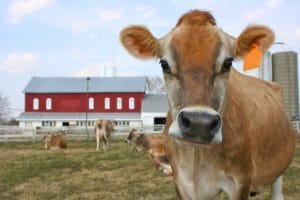Benefits Animal Welfare and Nutrition
[This article was previously published in the spring issue of The Cultivator, Cornucopia’s quarterly newsletter.]
by Kestrel Burcham, JD, Farm and Food Policy Analyst
at The Cornucopia Institute
 |
Consumers are now starting to look for “grass-fed” dairy, following exponential growth in the 100% grass-fed beef sector.
So what’s the difference between grass-fed dairy and conventional dairy, and why do consumers care?
Cattle, along with sheep and goats, are ruminants, meaning they evolved to eat and subsist on green forage.
Conventional agriculture relies on feeding ruminants things they are not meant to eat—grain, soy, and food by-products—to meet the energy needs demanded by cows being pushed for high production.
In contrast, organic dairies must pasture their animals during the grazing season. There is a minimum standard required for the amount of graze dairy animals must access if their products are certified organic.
All organic dairy is technically grass-fed, but not likely 100% grass-fed. It’s important to know the difference between these two designations, because an animal’s diet affects the milk nutrition, as well as livestock health and well-being.
The regulation of the terms “grass-fed” and “100% grass-fed” are not well defined at this point. In January of 2016, the United States Department of Agriculture (USDA) withdrew their previous “grass-fed” and “forage-fed” marketing verification claims for ruminant livestock and their meat products.
That change should have no impact on a producer’s ability to apply to the USDA’s Food Safety Inspection Service for a grass-fed claim on their label. However, while marketers cannot perpetuate misinformation in their labeling, consumer understanding of these terms can be a moving target.
While dairy products labeled “grass-fed” clearly must have received some grass in their diet, they may still be consuming significant amounts of grain and other feed. This is why all organic dairy is considered grass-fed.
The alternative, “100% grass-fed,” means the dairy animal received a diet composed entirely of forage (green-growing pasture and stored forage, such as hay).
Third-party certifications for grass-fed dairy products are gaining prominence and can give consumers some insight into products while shopping.
Third-party certifications all have different standards. These include labels like Certified Grassfed by A Greener World (a program started by Animal Welfare Approved), the American Grassfed Association, and Pennsylvania Certified Organic (which has a 100% Grassfed Organic certification). Some organic certifiers also certify grass-fed operations.
There are many benefits to dairy products sourced from 100% grass-fed animals. First, those ruminant livestock get themost natural diet possible, grazing on fresh pasture during the grazing season and usually eating stored forage (such as hay) during the non-grazing season.
Because of their diets, these cows are least likely to be found in intensive confinement. Instead, they live outside in social environments.
The grass-based diet itself makes the livestock healthier, requiring less intervention with drugs or other health remedies. Overall, this management provides many benefits for animal welfare.
There is a growing body of evidence showing that dairy from 100% grass-based operations have superior health benefits compared to their grain-fed counterparts.
Milk can be a good source of beneficial omega-3 fatty acids if the livestock are allowed to graze on pasture for all, or the majority of, their diet.
Another health benefit associated with grass-fed dairy products in particular is the high ratio of conjugated linoleic acids (CLAs). There is some scientific evidence that CLAs may help prevent cancer, acting as potent antioxidants and enhancing immune system function.
Like the higher ratio of omega-3s, CLAs are only present in high levels when a dairy animal gets most or all of its diet from fresh-growing grass.
Despite the benefits of grass-based dairying, it is still important for consumers to know their product suppliers. Buyers should beware of a grass-fed label that does not take into account how grazing practices impact the environment.
A grass-fed label reflects what animals are fed and doesn’t necessarily distinguish whether the milk product was produced on well-managed, environmentally friendly farms that are not overgrazed.
Choosing dairy products that are both organic and 100% grass-fed should ameliorate concerns of sustainability; improving soils and water quality, while maintaining biodiversity, are all defining principles of organic agriculture.
Despite the perceived animal welfare and health benefits associated with 100% grass-fed dairy products, the niche market has grown more slowly than the 100% grass-fed meat industry.
It is difficult to have an entirely forage-based dairy. These dairy farmers depend on climates where good grass grows naturally and on livestock breeds that thrive on all-grass diets.
The energy demands of lactation result in grass-based farmers producing much less milk per animal than their grain-fed counterparts.
That loss of revenue may be offset by lower operating and feed costs, as well as an added revenue stream from being able to sell a greater number of young calves (since their cows live longer, they need fewer in their operation), but it still can place producers on a thin profit margin.
However, financial benefits for marketers selling 100% grass-fed milk products are creating incentives for farmers to innovate.
While it can be difficult to run a successful 100% grass-fed dairy operation due to the high-energy demands of pregnancy and lactation, consumer demand is fueling this market. Many skilled practitioners are stepping up to the plate to meet that demand!
There is a lot to look forward to in this growing niche market. Many of the top brands highlighted in The Cornucopia Institute’s soon-to-be-released organic dairy scorecard sell dairy products from 100% grass-fed cows. The updated dairy report will go into detail about the benefits and challenges of 100% grass-fed dairying.
There is no doubt that the growing popularity and availability of these products within the organic industry is something consumers can look forward to.

